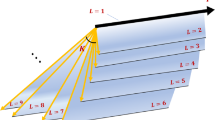Abstract
We consider a model of queues in discrete time, with batch services and arrivals. The case where arrival and service batches both have Bernoulli distributions corresponds to a discrete-time M/M/1 queue, and the case where both have geometric distributions has also been previously studied. We describe a common extension to a more general class where the batches are the product of a Bernoulli and a geometric, and use reversibility arguments to prove versions of Burke’s theorem for these models. Extensions to models with continuous time or continuous workload are also described. As an application, we show how these results can be combined with methods of Seppäläinen and O’Connell to provide exact solutions for a new class of first-passage percolation problems.
Similar content being viewed by others
References
Baryshnikov, Y.: GUEs and queues. Probab. Theory Related Fields 119, 256–274 (2001)
Bedekar, A.S., Azizog̃lu, M.: The information-theoretic capacity of discrete-time queues. IEEE Trans. Inform. Theory 44, 446–461 (1998)
Draief, M., Mairesse, J., O’Connell, N.: Queues, stores, and tableaux. J. Appl. Probab. 42, 1145–1167 (2005)
Ganesh, A., O’Connell, N., Prabhakar, B.: Invariant rate functions for discrete-time queues. Ann. Appl. Probab. 13, 446–474 (2003)
Hambly, B.M., Martin, J.B., O’Connell, N.: Concentration results for a Brownian directed percolation problem. Stoch. Process. Appl. 102, 207–220 (2002)
Hsu, J., Burke, P.J.: Behavior of tandem buffers with geometric input and Markovian output. IEEE Trans. Commun. COM-24, 358–361 (1976)
Kelly, F.P.: Reversibility and Stochastic Networks. Wiley, New York (1979). Electronic version available from http://www.statslab.cam.ac.uk/~frank/rsn.html
König, W., O’Connell, N., Roch, S.: Non-colliding random walks, tandem queues, and discrete orthogonal polynomial ensembles. Electron. J. Probab. 7(5) (2002) 22 pp. (electronic)
Mairesse, J., Prabhakar, B.: The existence of fixed points for the ⋅/GI/1 queue. Ann. Probab. 31, 2216–2236 (2003)
O’Connell, N.M.: Directed percolation and tandem queues. HP Labs technical report, HPL-BRIMS-2000-28, http://www.hpl.hp.com/techreports/2000/ (2000)
Reich, E.: Waiting times when queues are in tandem. Ann. Math. Statist. 28, 768–773 (1957)
Seppäläinen, T.: Exact limiting shape for a simplified model of first-passage percolation on the plane. Ann. Probab. 26, 1232–1250 (1998)
Takács, L.: Combinatorial Methods in the Theory of Stochastic Processes. Wiley, New York (1967)
Author information
Authors and Affiliations
Corresponding author
Rights and permissions
About this article
Cite this article
Martin, J.B. Batch queues, reversibility and first-passage percolation. Queueing Syst 62, 411–427 (2009). https://doi.org/10.1007/s11134-009-9137-6
Received:
Revised:
Published:
Issue Date:
DOI: https://doi.org/10.1007/s11134-009-9137-6




